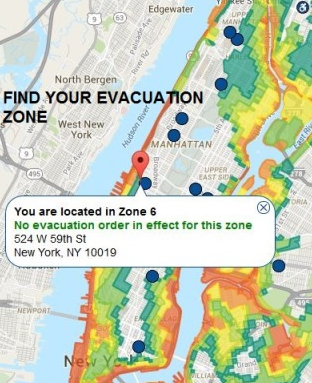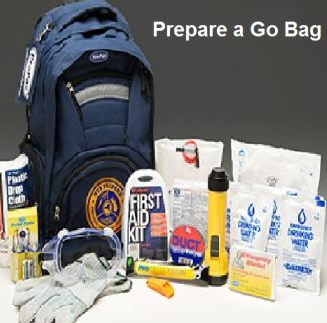Emergency Preparedness
EMERGENCY PREPAREDNESS OVERVIEW
PREPARING FOR AN EMERGENCY - PARTNERS IN PREPAREDNESS PROGRAM
1. Stay informed
2. Know your hurricane evacuation zone
3. Prepare a "Go Bag"
4. Make a Plan
IMPORTANT LINKS ON HOW TO PREPARE FOR EMERGENCIES AND DISASTERS
EMERGENCY PREPAREDNESS OVERVIEW
One measure of an organization's strength is its ability to respond well in an emergency. Presidents or their designees are responsible for emergency procedure planning, coordinating training, putting a plan into execution at their respective institutions, and updating plans in response to changes in circumstances.
Success in dealing with disasters is contingent upon the following:
- Planning - Identifying both natural and person-made disasters that could affect the campus and developing measures on how to respond to potential emergencies.
- Coordinating - Incorporating support from local government, civic agencies, and contractors that would be available to help both during and after the emergency.
- Training and Practicing - Developing a training program for the emergency management team to ensure they are aware of their responsibilities in dealing with emergencies. Practicing various scenarios with staff and faculty.
- Updating - Periodically updating the plan as situations at or around the campus change.
- Executing - When a crisis happens, putting the emergency plan into action, keeping in mind that as the situation develops, adjustments may be necessary.
The types of potential disasters that can affect a campus can be classified as natural or person-made disasters. Natural disasters for the most part are geographic in nature, while person-made disasters could take place at any property. Paramount in emergency planning is ensuring that all plausible emergency types are considered in the planning process.
Since every scenario cannot be predicted, an Emergency Response Plan (ERP) must also be able to quickly adapt to events as they unfold. The plan designates areas of responsibility and defines for the City University of New York the administrative framework responsive to emergency situations.The ERP is tailored to respond to campus emergencies at JJC. It is divided into two sections; administrative framework and response framework. It is imperative that individual departments develop response plans for situations that may develop under their purview. They will submit these plans to their immediate reports annually. The College response needs to be quick, professional, supportive, and meet the emerging demands of any emergency or crisis situation.
PREPARING FOR AN EMERGENCY
John Jay College has joined the NYC Office of Emergency Management (OEM) Partners in Preparedness (PIP) Program, which helps organizations prepare their communities for disasters. As part of this process, we would like to encourage all John Jay personnel and students to do the following:
1. Stay Informed
Click here to sign up for NotifyNYC, the City's free, real time emergency notification system to receive alerts by phone, text, or email. Information specific to John Jay will be on the College website. Links for emergency information and closings can be found here: EMERGENCY INFO AND CLOSINGS
Additional Resources:
- MTA for transportation updates
-LIRR and NJ Transit updates

CUNY Alert! Receive CUNY-related emergency alerts! Register using your CUNYfirst login or as a guest. For more information see CUNY Alert FAQs.


2. Know your Hurricane Evacuation Zone
Be familiar with the NYC Hurricane Map and know your evacuation zone. There are 6 zones. Zone 1 has the highest risk of storm surge impact. JJC's New Building and Haaren Hall are in Zone 6. Look up the zone for where you live at http://maps.nyc.gov/hurricane/. Visit the College's Hurricane Preparedness webpage for more information.
If John Jay College Needs to Evacuate, move at least 500 ft. away from the building.
The designated place of assembly for
New Building,
Haaren Hall,
Westport,
North Hall
is DeWitt Clinton Park, located at 11th Ave & 54th St.
Macaulay Honors College will relocate to Central Park on W. 67th Street.
Occupants of the following buildings, follow instructions of Building Managment:
BMW Building
619 W. 54th Street and
The New Yorker Hotel
Due to inclement weather conditions and non-reentry options, individuals may be advised to go home.

3. Prepare a Go Bag
Create a "Go Bag" so you will have necessary supplies, including:
- Copies of important documents in a waterproof and portable container (insurance cards, birth certificates, deeds, photo IDs, proof of address, etc.
- Extra set of car and house keys
- Copies of credit/ATM cards
- Cash (in small bills)
- Bottled water and non-perishable food, such as energy bars
- Flashlight
- Battery-operated radio
- Non-expired prescription medication
- First-aid kit
- Notepad and pen
- Contact and meeting place information for your household and a small regional map
- Lightweight rain-gear and Mylar blanket
- Childcare supplies, games, toys (if applicable)
- Pet items (if applicable)
- Back-up medical equipment, kits to repair flat wheelchair/scooter tires (if applicable)
- Items to comfort while in stressful situation


4. Make a Plan
Create a plan now for family members to meet at specified locations depending upon the circumstances of the emergency. Click here for more details on how to create a Family Emergency Plan.
IMPORTANT LINKS ON HOW TO PREPARE FOR EMERGENCIES AND DISASTERS
The following websites offer information about how to prepare for emergencies and disasters. Sponsored by various government agencies and non-profit organizations, these sites offer the most up-to-date and comprehensive preparedness information in the field of emergency management.
New York City Office of Emergency Management
PlanNowNYC (NEW!)
Ready New York (guide)
New York State Office of Emergency Management
Federal Emergency Management Agency
U.S. Department of Homeland Security
Ready.gov
U.S. Centers for Disease Control and Prevention Emergency Preparedness
The City University of New York